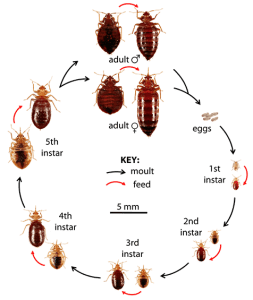Identification and Life Cycle
The bed bug, Cimex lectularius, is the most common of bed bug species. These small insects are usually active at night when people are sleeping and feed on human blood. Bed bugs are not known to transmit diseases and are sometimes mistaken for spider beetles, roaches and ticks.
Bed bugs are approximately 1/4 inch in size with flat oval bodies, long thin legs, and antennae. They are reddish-brown in color and have a long segmented proboscis (beak) that extends forward when taking a blood meal. The young nymphs resemble the adults but are light, translucent color.
Bed bugs must feed on blood to grow and the females need blood to develop eggs. She lays her eggs in secluded areas, depositing 1 to 5 a day and 500 during her one year lifetime. The eggs are tiny, whitish and hard to see on most surfaces. Oftentimes, the eggs are compared to a small sesame seed or a small grain of rice. Without feeding, nymphs can survive for months, while adults can survive for more than a year. They complete five growth stages from an egg to an adult in approximately 1 month.
Bed bugs can look different depending on their feeding status. An unfed adult bed bug can appear flat, once it takes a blood meal it plumps up like an elongated balloon and becomes a bright red color.
Bed bugs usually breed high in number and it fastly gets spread all over your facility. Proper & professional extermination process will put an end to their wings as these are unwanted guests in our property. If you feel unsafe with bed bug infestation, feel free to call bed bug controllers nearby.





Comments are closed.